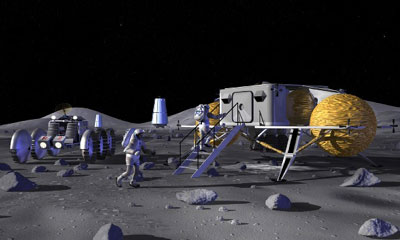Estimating the cost of the visionby Dwayne A. Day
|
| The CBO has determined that, through 2020, NASA will require $32 billion more than the agency is currently projecting for its budget in order to pursue the exploration plan. |
The CBO came to its conclusions by looking at the historical cost growth in NASA programs and then applying this to the current plans. Perhaps one of the more interesting revelations in this report is that nobody has really done this kind of evaluation before. It has long been known that civilian space projects run over budget, but when one looks for data on past performance, there has been little independent analysis of this subject. In fact, the last non-NASA assessment of this issue appears to have been a 1992 General Accounting Office report. (See page. 10, footnote 1.) Certainly, given the amount of criticism NASA gets for its cost estimates, one would hope for more attention to this subject. But in the past decade, space experts in all of the congressional agencies have received fewer requests from Congress to assess NASA programs.
There is another worthwhile revelation in the report, which is that despite its horrible reputation for cost estimation—which the press always trumpets and often exaggerates—NASA is actually no worse at estimating cost growth than the Department of Defense. Both the DoD and NASA have a cost growth risk (CGR) factor of around 1.45. The CGR is the ratio of actual costs to initial estimates, and what it means is that on average, once the effects of inflation have been removed, NASA projects cost 45% more than the agency initially estimates, about the same for DoD weapons programs. (See pages 10-11.)
Unfortunately, the media simply assumes that NASA is always way off on its estimates and makes no attempt to develop realistic estimates of their own. When the Bush plan was announced back in January, many media outlets reported that the plan would cost $1 trillion. The CBO is now saying that it will probably cost $127 billion. In other words, the press was only off by $873 billion. Even Alex Roland, a former NASA historian who never misses an opportunity to bash the agency he once worked for (which oddly gives him credibility in the eyes of some media outlets) estimated that it would cost $100 billion simply to develop a new heavy lift launch vehicle. A more realistic estimate is about a fifth of that, including initial test launches and the first human landing of the lunar return mission. Despite all of the criticism, one can conclude that NASA does a better job of estimating its project costs than many in the media.
However, the CBO report also points out a few other facts that have largely escaped attention. For instance, in February NASA produced a brochure on the Vision for Space Exploration that included a space exploration roadmap indicating an initial human lunar landing by 2015, with four more potential landing opportunities through the end of the decade. However, NASA’s internal budgeting does not match this schedule. Right now the plan is for first launch of a partially capable Crew Exploration Vehicle prototype by 2008, first unmanned test of a fully capable unit by 2011, and first human flight by 2014. Development of the lunar lander would begin in 2011, with a single landing in 2020, not 2015. In fact, there is no funding for a lunar habitation module in the current budget, nor for any of the projected follow-on missions included in the publicly released lunar roadmap. All of those missions occur after 2020 and are not included in the budgeting “sand chart” that was used during budget hearings earlier this year.
| In fact, there is no funding for a lunar habitation module in the current budget, nor for any of the projected follow-on missions included in the publicly released lunar roadmap. |
If future administrations and Congresses are going to continue to pursue the Vision for Space Exploration in the same way it is now planned, they have several options. One option is to increase funding for NASA and give the agency the money it needs to conduct the program. However, the current administration has indicated that it will not plan for future increases in NASA’s budget above a relatively modest 2% inflation rate. This means that the agency has to find the money in some other way. CBO indicates that one option would be to take the money from elsewhere in NASA’s budget, such as canceling the International Space Station and Space Shuttle programs. Those projects are considered relatively untouchable, however, because of American commitments to the ISS foreign partners. The money would more likely have to come from elsewhere in the agency’s budget, but that could devastate other areas like astrophysics and aeronautics that are already under tight budgets. Another option is to extend out the date of the initial lunar landing from three to four years, meaning a first landing by no earlier than 2023. However, the CBO noted that it did not calculate the costs of such delays—for instance, all the people working on the projects still have to be paid for those additional years—and the result could be even further delays.
Currently NASA is involved in a bruising fight for its budget on Capitol Hill. The agency also will apparently seek an additional billion dollars or more for a robotic servicing mission to the Hubble Space Telescope. There are now reports of extensive damage at Cape Canaveral due to Hurricane Frances that will undoubtedly require more money to repair. Some at the agency may not welcome this new CBO report that indicates that the new space plan is going to cost more than the agency has calculated. However, the information in the report is worth knowing. Debating the agency’s options from a position of ignorance is not a good strategy for Congress, the White House, or NASA itself.
